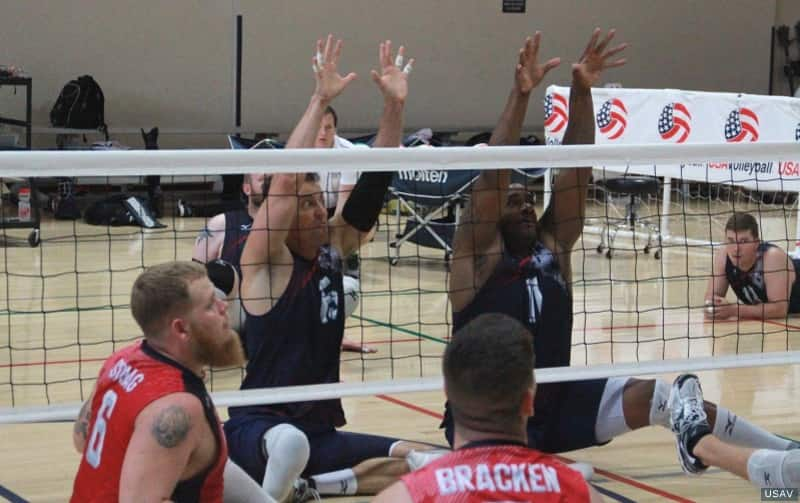
COLORADO SPRINGS, Colo. (Aug. 26, 2016) – When Chris Seilkop got a call from a former teammate Jose Zabala asking him to play in the sitting volleyball division of the 2015 USA Volleyball Open National Championships on a team for the Florida Region, the 6-6 middle blocker wasn’t sure what to think.
He’d been happily retired for about eight years, living and working in Texas with his wife Rhonda and daughters Tori and Isabel. Seilkop agreed to play, also recruiting former U.S. Men’s Sitting Team captain, teammate and friend Brent Rasmussen to join him.
“During Opens, I had dinner with (current U.S. Men’s Sitting Team athletes) Charlie (Swearingen) and J. Dee (Marinko), and really enjoyed meeting them. When they asked me if I’d be interested in coming back, I gave it some serious thought,” Seilkop said.
Now, less than two years later, Seilkop is making his fourth trip to the Paralympics as a member of the 2016 U.S. Men’s Paralympic Sitting Team hoping to help the team make history and earn its first Paralympic medal. The trip to Rio de Janeiro comes 20 years after Seilkop’s Paralympic debut on the U.S. Paralympic Standing Volleyball Team at the 1996 Atlanta Games.
Seilkop is the first to admit it sounds crazy when it’s pointed out that current teammate Ben Aman was just four years old and attending pre-school when Seilkop joined the Paralympic team two decades ago. But age is only a number to the man who lost the lower part of his right leg following a lawn mower accident at age 7.
Seilkop was inspired to try volleyball after watching volleyball legend and current U.S. Women’s Head Coach Karch Kiraly and his teammates win gold in 1984. He dabbled in the sport recreationally, but focused on basketball through high school. In 1995, Seilkop learned of the U.S. Paralympic Standing Volleyball Team through an article in Volleyball Magazine. A phone call to the assistant coach led to an impromptu tryout with the team and shortly after Seilkop was getting regular playing time as the starting middle blocker.
He transitioned to sitting volleyball after the 2000 Sydney Paralympics and now prefers sitting as it’s less taxing on the body.
“One thing I really like about sitting volleyball is that you can play in your older years. I had to stop playing standing because it killed my knees, but I don’t have that pain with sitting volleyball,” Seilkop said.
After serving multiple roles on previous teams, including team captain and starting outside hitter and setter for many years, Seilkop finds himself as a role player on the current team, which suits him well.
“I probably won’t start, which I’m fine with. When I came back and talked to the coaches, I told them I didn’t want to be the star. It’s a different mindset where it’s much more of a support role,” Seilkop said.
Since rejoining the team in November 2015, Head Coach Greg Walker said Seilkop’s presence has bolstered a roster brimming with talent and potential.
“He has a great commitment to servant leadership, and it’s been nice to see how he’s slipped back into the team atmosphere,” Walker said. “I really like that he takes the things the coaching staff is trying to implement to heart and his level of commitment is a great example to some of the younger players.”
Next week Seilkop and his teammates depart for Rio de Janeiro in the U.S. Men’s Sitting Team’s first Paralympic appearance since 2004. Only Seilkop and current team captain Eric Duda were members of that team, which finished 2-3, in sixth place.
The 2016 team hopes to improve on its performance in March at the World ParaVolley Intercontinental Cup when the U.S. finished 0-7, winning just one set against China in pool play. The 2016 Paralympics begin Sept. 7 in Rio de Janeiro; the sitting volleyball competition begins Sept. 9, ending Sept. 18, the same day as the Closing Ceremony. The U.S. is set to play Brazil, Germany and Egypt in pool play, although a match schedule has not yet been released.
